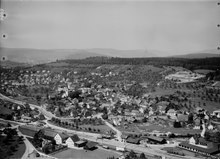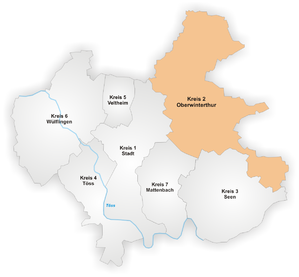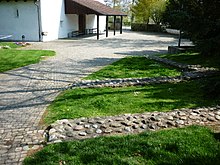Oberwinterthur
|
Oberwinterthur (District 2) City district of Winterthur |
|
|---|---|
| Coordinates | 700 175 / 263 729 |
| surface | 17.4 km² |
| Residents | 24,221 (December 31, 2019) |
| Population density | 1392 inhabitants / km² |
| Incorporation | Jan. 1, 1922 |
| BFS no. | 230-200 |
| Post Code | 8400, 8404, 8409, 8352 |
| structure | |
| Quarters | |
Oberwinterthur (colloquially Oberi ) is an urban district of the city of Winterthur in Switzerland . The formerly independent municipality of Oberwinterthur was incorporated in 1922 and forms today's district 2 .
coat of arms
The blazon reads: Divided, above in gold a striding red lion, below, sheathed in blue and silver .
geography
The urban district of Oberwinterthur is located in the northeast of the city of Winterthur. A largely intact town center with half-timbered buildings and cobblestones forms the center of Oberwinterthur. The urban district is divided into nine quarters with very different structures. Talacker and Guggenbühl are two older residential areas with a high population density. Reutlingen, Stadel and Ricketwil were able to maintain their village character as so-called external guards . The Grüze and Hegmatten quarters are characterized by industrial buildings. The Zinzikon and Hegi districts are developing dynamically due to high construction activity.
history

The Oberwinterthur church hill is probably the place of the earliest settlement of the city of Winterthur. It is believed that people settled here as early as the end of the Ice Age. The hill also formed the core of the Roman settlement of Vitudurum . There was, among other things, a temple, a barracks and, according to an inscription, a Roman fort from AD 294 to protect the place from Germanic invasions. Archaeological excavations provide extensive evidence of Oberwinterthur's Roman past. The place is one of the most important archaeological sites in the canton of Zurich. Around 400 AD the Roman settlement came to an abrupt end with the withdrawal of the Romans from this area.
Oberwinterthur was later mentioned again as Venterdura (843 AD) and Winterduro (856 AD). Around 919 Oberunwinterthur is mentioned again in a document. At that time Niederwinterthur , which corresponds to today's old town, had to pay tithing to the Oberwinterthur church (which is built on the former Roman temple). At that time there was probably a competitive situation between the two places Oberwinterthur and Niederwinterthur or Winterthur. Oberwinterthur lost its supremacy over Niederwinterthur at the latest when the Kyburgers gained power , who made Winterthur their capital. One of the oldest surviving buildings in Oberwinterthur is the Hohlandhaus , which was built as a warehouse in 1117 and served as the administrative center from the 14th century.
Until industrialization , Oberwinterthur was a simple vine-growing village for a long time. In addition to viticulture , its residents also cultivated arable land and raised livestock. In 1849 the first industrial company was established, the machine factory, cotton twisting and dyeing mill Jakob Jaeggli. Other companies followed, including a branch of the industrial group Sulzer Brothers . The establishment of industry in Oberwinterthur was favored by the newly built railway lines (1860 to Romanshorn , 1875 the Tösstalbahn and the national railway ).
Before it was incorporated into the city of Winterthur, the political municipality of Oberwinterthur comprised the civil parishes of Grundhof, Hegi, Reutlingen, Ricketwil, Stadel and Zinzikon. In 1922 Oberwinterthur was incorporated into the city of Winterthur with the other suburbs.
See also: Vitudurum , Winterthur # history
traffic
Public transport
Oberwinterthur has good transport connections with five train stations. The most important station is the Oberwinterthur train station . From here rail lines lead to Winterthur train station , to Stein am Rhein and to Frauenfeld . The S11, S24, S29 and S30 of the Zurich S-Bahn and a night line from Thurbo stop at the station . The station is also the terminus of several regional bus and post bus lines . These buses serve communities in the northwest of Winterthur.
Other train stations in Oberwinterthur are Winterthur-Wallrüti, Winterthur-Reutlingen, Winterthur-Grüze and Winterthur-Hegi (opened in 2006).
Oberwinterthur is also served by several trolleybus and bus routes from Stadtbus Winterthur . Among other things, line 1 (Töss-HB-Oberwinterthur), line 5 (Dättnau-HB-Technorama), line 10 (HB-Bahnhof Oberwinterthur) and line 7 (Wülflingen-HB-Chlihegi station) run through the Oberwinterthur district . From 1931 to 1951, line 1 of the Winterthur tram ran to Oberwinterthur station.
Private transport
The district has its own motorway exit with the Oberwinterthur exit on the A1 in the north-west. In addition, the Swiss main roads Frauenfeld-Zurich ( Hauptstrasse 1 ) and Wil-Winterthur ( Hauptstrasse 7 ) cross the district.
population
Oberwinterthur is the largest district in terms of population in Winterthur. Every fifth Winterthur resident lives in Oberwinterthur.
22% of the population are of children and youth, 65% of working age and 13% of retirement age.
Oberwinterthur has a share of 27% foreigners. The proportion of foreigners in the population varies depending on the district. Guggenbühl (34%), Grüze (31%) and Hegmatten (28%) have high rates of foreigners. Few foreigners live in the Ricketwil (4%), Stadel (12%) and Reutlingen (15%) external guards. The largest groups of migrants in Oberwinterthur come from the former Yugoslavia (5% of the resident population), Germany (5%) and Italy (4%).
education
Oberwinterthur forms its own school district of the city of Winterthur with 14 kindergartens (Eulachpark, Gerzler, Hegifeld, Im Gern, Zinzikon, Oberi-Dorf, Neuhegi, Reismühle, Schooren, Stadel, Talwiesen, Unteres Bühl, Unterwegli, Wallrüti), 11 primary schools (Eulachpark, Guggenbühl, Hegi, Hegifeld, Neuhegi, Römerstrasse, Reutlingen, Rychenberg, Stadel, Talacker and Zinzikon ) and 3 high schools (Lindberg, Rychenberg and Wallrüti). The numerous schools and kindergartens are organized into six managed school units. The lower secondary level in Oberwinterthur is organized according to the model of a structured secondary school.
Attractions
Arts and Culture
Technorama , the largest science center in Switzerland and the most visited museum in the city of Winterthur, is located in Oberwinterthur .
On the last weekend of the summer school holidays, the residents of Oberwinterthur celebrate the Oberi-Fäscht . Associations and institutions offer culinary delicacies, drinks and other attractions in the historic center of Oberwinterthur.
Under the name Oberi Sounds Good , the Oberwinterthur local association is organizing a music event with renowned musicians from the styles of swing, blues, boogie woogie and New Orleans jazz.
Historic Buildings
The Church of St. Arbogast in the center of Oberwinterthur stands on the ruins of Roman thermal baths and a Gallo-Roman temple from the 2nd century AD. The church has unique wall paintings from the early 14th century. The patron saint of the today reformed church is St. Arbogast of Strasbourg.
The Hegi Castle was noble for centuries residing families. The castle houses a public museum. The castle park is freely accessible.
The Mörsburg Castle is located in the far east of Oberwinterthur. It was first mentioned in 1241. The museum in Mörsburg shows living culture of the 17th / 18th centuries. Century as well as a weapons and glass collection.
literature
- Hans Kläui: History of Oberwinterthur , 2 volumes, Winterthur City Library 1968–1971.
- Werner Leimbacher, Willi Reutimann (photographer): Oberi - then and now Oberwinterthur local association, Winterthur 2001, ISBN 3-9522290-0-8 .
- Jürg Rychener: The church hill of Oberwinterthur. The rescue excavations in 1967, 1980 and 1981 . Orell Füssli, Zurich 1984, ISBN 3-280-01591-X (= contributions to the Roman Oberwinterthur - Vitudurum , volume 1).
- H. Wyler: The municipality of Oberwinterthur before incorporation , in: Winterthurer Yearbook 1972 , Fabag, Winterthur 1972.
- Walter Drack, Karl Keller, Albert Knoepfli : The Reformed Church of St. Arbogast in Oberwinterthur . GSK , Bern 1984, ISBN 3-85782-354-2 (= Swiss Art Guide , Series 36, Volume 354).
- Peter Niederhäuser: Oberwinterthurer Kirchengeschichten , Zurich 2015, ISBN 978-3-0340-1319-2 .
Web links
- Local association Oberi
- Alfred Häberle: Oberwinterthur. In: Historical Lexicon of Switzerland .
- Office for Spatial Development, Canton of Zurich: Oberwinterthur - Vicus Vitudurum
Individual evidence
- ↑ StiASG , Urk. III 214. Online at e-chartae , accessed on June 19, 2020.
- ↑ District mirror 2018 Winterthur
- ^ School Oberi school buildings
- ^ Albert Knoepfli, Karl Keller, Walter Drack: The Reformed Church of St. Arbogast in Oberwinterthur. (Swiss Art Guide, No. 354). Ed. Society for Swiss Art History GSK. Bern 1984, ISBN 978-3-85782-354-1 .







